Great Trek

The Great Trek (Afrikaans: Die Groot Trek; Dutch: De Grote Trek) was an eastward and north-eastward emigration away from British control in the Cape Colony during the 1830s and 1840s by Boere (Dutch/Afrikaans for "farmers"). The migrants were descended from settlers from western mainland Europe, most notably from the Netherlands, north-west Germany and French Huguenots. The Great Trek itself led to the founding of numerous Boer republics, the Natalia Republic, the Orange Free State and the Transvaal being the most notable. The trek also resulted in the defeat of Mzilikazi and the subsequent expulsion of the Northern Ndebele people to present day Zimbabwe and the defeat of the Zulu king, Dingane.
Background
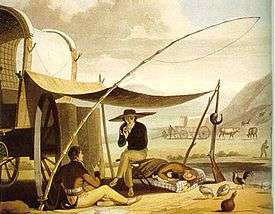
The Voortrekkers comprised two groups from the eastern frontier region of the Cape Colony, semi-nomadic pastoralists known as Trekboers, and established farmers and artisans known as Grensboere, or Border Farmers. Amongst the Voortrekkers were poor men too belonging to the squatter or bywoner class.[1] Together these groups were later called Voortrekkers (Pioneers). While most settlers who lived in the western Cape (later known as the Cape Dutch) did not trek eastward, a small number did.[2]
The first colonists, who arrived in 1652 to set up a depot for the provision of ships under the auspices of The Dutch East India Company, were of Dutch stock.[3] Many later settlers were of German origin[4] and after the revocation of the Edict of Nantes in 1685, French Huguenot refugees.[5] By 1800, white colonists numbered slightly less than 40,000 and were so interconnected by marriage that they represented a giant family rather than a new polyglot community. The community was governed by The Council of Seventeen in Amsterdam, who governed the far-reaching empire of the Dutch East India Company.[3] During the Napoleonic Wars (1803-1815) the colony passed into the control of the United Kingdom of Great Britain and Ireland.[6] This was formally ratified in 1815 by the Congress of Vienna. All inhabitants of the now British Colony therefore became British subjects.
Causes of the trek
Historians have identified various factors that contributed to the migration of an estimated 12,000 Voortrekkers to the future Natal, Orange Free State and Transvaal regions. The primary motivations included discontent with the British rule:
- Anglicisation policies (especially in official circles, at the expense of the 'taal' (mother tongue).[7])
- Restrictive laws on slavery and its eventual abolition
- Arrangements to compensate former slave owners (which were considered inadequate during harvest season.[7])
- The perceived indifference of British authorities to border conflicts along the Cape Colony's eastern frontier.
- The Boers had been blamed by the Government for provoking an unjust war.[7]
- Land was becoming scarce and expensive owing to the natural increase in the Afrikaans-speaking population and the advent of 5,000 British settlers during 1820.[7]
- Droughts[7]
- The chronic mortifications at the way the Boers' actions were so freely criticised by the missionaries.[8]
- The official recognition of the equality between coloured men and whites.[8]
- The British authorities had stopped ammunition being traded across the Orange, and someone like Jan Pretorius, the sub leader of the Tregardt trek, wanted to buy gunpowder from the Portuguese in Lourenco Marques, and he thought that joining Tregardt's caravan was the safest way of getting there.[9]
Many contemporary sources argue that Ordinance 50 (1828), which guaranteed equal legal rights to all free persons of colour, and prohibitions on inhumane treatment of workers, spurred the Boer migrations.[10] However, some scholars argue that most Trekboers did not own slaves, unlike the more affluent Cape Dutch who did not migrate from the western Cape. The three republics subsequently founded by the Voortrekkers prohibited slavery, but enshrined racial separatism in their constitutions.
A preparatory trek to Natal was planned called the "Kommissietrek" or Commission Trek that would lay the groundwork of the coming exodus from the Cape.
Other possible factors included the desire to escape from relentless border wars with the Xhosa along the eastern frontier of the Cape colony. The migrants also sought fertile farmland, as good land was becoming scarce within the colony's frontiers. The Great Trek also resulted from increasing population pressures, as Trekboer migrations eastward had come to a virtual stop for at least three decades, though some Trekboers did migrate beyond the Orange River prior to the Great Trek.
The Great Trek was made up of a number of waves of parties and migration of Dutch/Proto-Afrikaans speaking settlers from the Cape Colony to most of the rest of what is today modern-day South Africa and Johannes Hans van Rensburg's failed trek to Portuguese Mozambique.[11]
At the time officials and church elders in the Cape Colony condemned the trek for a variety of reasons. Some were concerned about the fate of the trekkers such as prominent frontier colonist Gideon Joubert who expected them to be destroyed and the survivors forced to return in a state of absolute poverty. Whilst others such as the frontier official Andries Stockenstrom were concerned over the impact on neighbouring black tribes that they might be reduced to a state penury similar to that of the pre-1828 Khoi-Khoi before the abolition of slavery.[12] :161
Exploratory trek
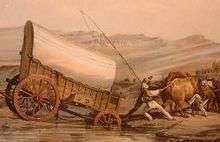
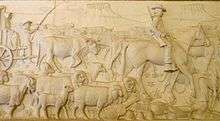
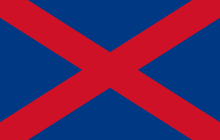
In January 1832 Dr. Andrew Smith, an Englishman, and a Boer farmer William Berg were sent by the Cape Dutch Boer leaders to investigate Natal for potential settlement. On their return to the Cape, Dr. Smith was very enthusiastic and the impact of discussions William Berg had with the Boers proved crucial. Berg reported that Natal was a land of exceptional farming quality, was well watered and nearly devoid of inhabitants.
In June 1834, the Boer leaders of Uitenhage and Grahamstown discussed a so-called Kommissietrek or "Commission Trek" to visit Natal and assess its potential as a new homeland for the discontented Cape Boers who were disenchanted with British rule at the Cape. Petrus Lafras Uys was chosen as trek leader.
In June 1834, Jan Gerritze Bantjes at Graaff Reinet got to hear about this exploratory trek to Port Natal to investigate the possibility of a new Dutch settlement there, and encouraged by his father Bernard Louis Bantjes, word was sent to Uys of his interest to partake in this great adventure. Bantjes wanted to help re-establish Dutch independence over the Boers and get away from British law at the Cape. J.G.Bantjes was already well known in the area as an educated young man fluent in both spoken and written Dutch and English and was, due to these skills, invited by Uys to join this voyage of discovery to Natal. J.G.Bantjes’ writing skills would be invaluable in recording events as the journey unfolded.
On Monday, 8 Sept. 1834, the Boer Kommissietrek of 20 men and one woman including a retinue of coloured servants, set off from Grahamstown for Natal with 14 wagons. Moving through the Eastern Cape, they were welcomed by the Xhosa who were at loggerheads with the neighbouring Zulu King Dingaan, and they passed unharmed into Natal. They travelled more or less the same route as Dr. Andrew Smith had taken two years earlier.
The trek avoided the coastal route, keeping to the flatter inland terrain. The kommissietrek approached Port Natal from East Griqualand and Ixopo, crossing the upper regions of the Umtumvuna and Umkomaas rivers. The travel pace was slow due to the rugged terrain, and since it was the summer, the rainy season had swollen many of the rivers to their maximum. Progress required days of scouting to locate the most suitable tracks to negotiate. Eventually after weeks of incredible toil, the small party arrived at Port Natal crossing the Congela river and weaving their way through the coastal forest into the bay area. They had travelled a distance of about 650 km from Grahamstown. This trip would have taken about 5–6 months with their slow moving wagons. The Drakensberg route via Kerkenberg into Natal had not yet been discovered.
They arrived at the sweltering hot bay of Port Natal in Feb. 1835 exhausted after their long journey. At Port Natal the trek was soon welcomed with open arms by the few British hunters and ivory traders there such as James Collis including semi-invalid Allen (Rev.) Francis Gardiner (1794-1851), an ex-commander of the Royal Navy ship Clinker, who had decided to start a mission station there. The British had their camp near the Point sand banks in thick coastal forest overlooking the entrance to the bay. After congenial exchanges between the Boers and British sides, the party settled in and Richard (Dick) King (1813-1871) was invited to become their guide.
In early August 1834, Jan Gerritze set off with some travellers headed for Grahamstown 220 km away, a three-week journey from Graaff Reinet. Sometime around late August 1834 Jan Gerritze Bantjes arrived in Grahamstown and contacted Uys and made his introductions. There, Jan Gerritze met up with the other expedition team members, secured supplies and got ready for the long journey ahead.
The Boers set up their laager camp in what is now the Greyville race course area being more open where suitable grazing was available to the oxen and horses, and as far as possible from the foraging hippos in the bay. Several small streams running off the Berea provided fresh water for the trekkers. Alexander Biggar (1781-1838) was also at the bay as a professional elephant hunter and helped the trekkers with important information regarding conditions at Port Natal. Bantjes made notes suggested by Uys which were later used in his more comprehensive report on the positive aspects of Natal. Bantjes also made rough maps of the bay (this journal now missing) showing the potential for a harbour which could supply the Boers in their potential new homeland.
At Port Natal, Dick King who was there and could speak Zulu, was sent by Uys to Umgungundlovu to investigate with Dingaan the possibility of granting them land to settle, when Dick King returned to Port Natal some weeks later, he reported that Dingaan insisted they visit him in person. Johannes Uys, brother of Petrus Uys and a number of comrades with a few wagons, travelled toward Dingaan’s capital at Umgungundlovu, and making a laager of wagons at the mouth of the Mvoti River, they proceeded on horseback, but were halted by a full flooded Tugela River and forced to return to the laager.
The Kommissietrek with a good stash of ivory left Port Natal for Grahamstown in early June 1835 following more or less the same route back to the Cape, arriving at Grahamstown in October 1835 to a great welcome. On Uys’s recommendation, Bantjes set to work on the first draft of the Natalialand Report. Meetings and talks were held in the main church to much approval and the first sparks of Trek Fever began to take hold. From all the information accumulated at Port Natal, Jan Gerritze Bantjes drew up the final report on "Natalia or Natal Land" that acted as the catalyst which inspired the Boers at the Cape to set in motion the Great Trek away from the British at the Cape.
First wave
| Largest first wave trek parties[12]:162–163 | ||||
|---|---|---|---|---|
| Leader | Date of departure | Point of departure | Size | |
| Louis Tregardt | September 1835 | Nine families including the Tregardt family | ||
| Hans van Rensburg | September 1835 | 49 | ||
| Hendrik Potgieter | late 1835 or early 1836 | Over 200 once united with the parties of Sarel Cilliers and Casper Kruger. | ||
| Gerrit Maritz | September 1836 | Graaff-Reinet | Over 700 people including roughly 100 white males | |
| Piet Retief | February 1837 | Albany | Roughly 100 men, women, and children. | |
| Piet Uys | April 1837 | Uitenhage | Over 100 members of the Uys family. | |
The first wave of Voortrekkers lasted from 1835 to 1840, during which an estimated 6,000 people (roughly 20% of the Cape Colony's total population or 10% of the white population in the 1830s) trekked.[12]
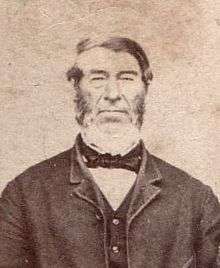
The first two parties of Voortrekkers left in September 1835 led by Louis Tregardt and Hans van Rensburg respectively. These two parties crossed the Vaal river at Robert's Drift in January 1836, but in April 1836 the two parties split up, just seventy miles from the Zoutpansberg mountains, following differences between Tregardt and Van Rensburg.[13] A later party led by Hendrik Potgieter trekked out of the Tarka area in either late 1835 or early 1836, and in September 1836 a party led by Gert Maritz began their trek from Graaff-Reinet. There was no clear consensus amongst the trekkers on where they were going to settle, but they all had the goal of settling near an outlet to the sea.[12]:162,163
In late July 1836 Van Rensburg's entire party of 49, except two children (who were saved by a Zulu warrior), were massacred at Inhambane by an impi of Manukosi.[14] Included in the party was Nicholaas Balthasar Prinsloo, his wife, Petronella Maria Krugel/Kruger and their family.[15]
Those of Tregardt's party that settled around Soutpansberg moved on to try and settle Delagoa Bay with most of the party perishing, including Tregardt, from fever.[12]:163
Despite pre-existing peace agreements with local black chiefs, in August 1836 a Ndebele patrol attacked the Liebenberg family part of Potgieter's party killing six men, two women and six children. It is thought that their primary aim was to plunder the Voortrekker's cattle. On the 20 October 1836 Potgieter's party was attacked by an army of 4,600 Ndebele warriors at the Battle of Vegkop. Thirty-five armed trekkers repulsed the Ndebele assault on their laager with the loss of two men and almost all the trekkers' cattle. Potgieter, Uys and Maritz mounted two punitive commando raids. The first resulted in the sacking of the Ndebele settlement at Mosega, the death of four hundred Ndebele and the taking of 7000 cattle. The second commando resulted forced Mzilikazi and his followers to flee to what is now modern day Zimbabwe.[12]:163
By spring (September/October) 1837 five to six large Voortrekker settlements had been established between the Vaal and Orange Rivers with a total population of around 2,000 trekkers.
Natal conflicts

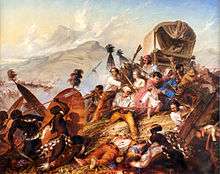
In October 1837 Retief met with Zulu king Dingane to negotiate a treaty for land to settle in what is now Kwa-Zulu Natal. Dingane, feeling suspicious and insecure due to previous Voortrekker influxes from across the Drakensberg, had Retief and seventy of his followers killed.[12]:164
Various interpretations of what exactly transpired exist, as only the missionary Francis Owen's written eye-witness account survived.[16] Retief's written request for land contained veiled threats by referring to the Voortrekker's defeat of indigenous groups encountered along their journey. The Voortrekker demand for a written contract guaranteeing private property ownership was incompatible with the contemporaneous Zulu oral culture which prescribed that a chief could only temporarily dispense land, which was communally owned.[17]
Most versions agree that the following happened: Dingane's authority extended over some of the land in which the Boers wanted to settle. As prerequisite to granting the Voortrekker request, Dingane demanded that the Voortrekkers return some cattle stolen by Sekonyela, a rival chief. After the Boers retrieved the cattle, Dingane invited Retief to his residence at uMgungundlovu to finalise the treaty, having either planned the massacre in advance, or deciding to do so after Retief and his men arrived.
Dingane's reputed instruction to his warriors, "Bulalani abathakathi!" (Zulu for "kill the wizards") showed that he may have considered the Boers to wield evil supernatural powers. After killing Retief's delegation, a Zulu army of 7,000 impis were sent out and immediately attacked Voortrekker encampments in the Drakensberg foothills at what later was called Blaauwkrans and Weenen leading to the Weenen massacre in which 282 Voortrekkers, of whom 185 children, were killed. In contrast to earlier conflicts with the Xhosa on the eastern Cape frontier, the Zulu killed the women and children along with the men, wiping out half of the Natal contingent of Voortrekkers.
The Voortrekkers retaliated with a 347-strong punitive raid against the Zulu (later known as the Flight Commando), supported by new arrivals from the Orange Free State. They were roundly defeated by about 7,000 warriors at Ithaleni, southwest of uMgungundlovu. The well-known reluctance of Afrikaner leaders to submit to one another's leadership, which later so hindered sustained success in the Anglo-Boer wars, was largely to blame.
In November 1838 Andries Pretorius arrived with a commando of sixty armed trekkers and two cannons to assist in the defence. A few days later on the 16 December 1838 a force of 468 trekkers, 3 Britons, and 60 black allies fought against 10,000 to 12,000 Zulu impis at the Battle of Blood River. Pretorius's stunning victory over the Zulu army led to a civil war within the Zulu nation as Dingane's half-brother, Mpande, aligned with the Voortrekkers to overthrow Dingane and impose himself as king. Mpande sent 10,000 impis to assist the trekkers in follow-up expeditions against Dingane.[12]:164
After the defeat of the Zulu forces and the recovery of the treaty between Dingane and Retief from Retief's skeleton, the Voortrekkers proclaimed the Natalia Republic.[18] This Boer state was annexed by British forces in 1843.[19] After Dingane's death and Mpande proclaimed king the Zulu nation allied with the short lived Natalia Republic until its annexation by the British Empire in 1843.[12]:164[20]
The Voortrekkers' guns offered them an obvious technological advantage over the Zulu's traditional weaponry of short stabbing spears, fighting sticks, and cattle-hide shields. The Boers attributed their victory to a vow they made to God before the battle: if victorious, they and future generations would commemorate the day as a Sabbath. Thereafter the 16 December was celebrated by Boers as a public holiday, first called "Dingane's Day," later changed to the Day of the Vow. The name was changed to the Day of Reconciliation by the post-apartheid South African government, in order to foster reconciliation between all South Africans.[20]
Impact
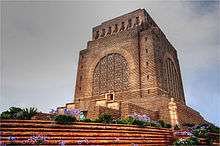
Conflict amongst the Voortrekkers was a problem as the leveling effect of the trek on pre-existing class hierarchy to enforce discipline undermined social cohesion. Instead the trek leaders became more reliant on patriarchal family structure and military reputation to maintain control over their parties. This had a large and lasting impact on Afrikaans culture and society.[12]:163
Centenary celebrations
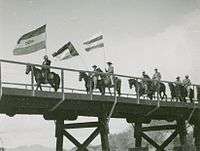
.jpg)
The celebration of the Great Trek in the 1930s play a major role in the growth of Afrikaans nationalism. It is thought that the experiences of the Second Boer War and the following period, between 1906 and 1934, of a lack of public discussion about the war within the Afrikaans community helped set the scene for a large increase in interest in Afrikaans national identity. The celebration of the centenary of the Great Trek along with a new generation of Afrikaners interested in learning about the Afrikaans experiences of the Boer War catalyzed a surge of Afrikaans nationalism.[12]:433
The centenary celebrations began with a re-enactment of the trek beginning on 8 August 1938 with nine ox wagons at the statue of Jan van Riebeeck in Cape Town and ended at the newly completed Voortrekker Monument in Pretoria and attended by over 100,000 people. A second re-enactment trek starting at the same time and place ended at the scene of the Battle of Blood River.[12]:432
The commemoration sparked mass enthusiasm amongst Afrikaners as the re-enactment trek passed through the small towns and cities of South Africa. Both participants and spectators participated by dressing in Voortrekker clothing, renaming streets, holding ceremonies, erecting monuments, and laying wreaths at the graves of Afrikaner heroes. Cooking meals over an open fire in the same way the Voortrekkers did became fashionable amongst urbanites giving birth to the South African tradition of braaing.[12]:432 An Afrikaans language epic was made to coincide with the 100th anniversary of the Great Trek, Die Bou van 'n Nasie (1938). The film told the Afrikaans version of the history of South Africa from 1652 to 1910 with a focus on the Great Trek.[21]
A number of Afrikaans organisations such as the Afrikaner Broederbond and Afrikaanse Taal en Kultuurvereniging continued to promote the centenary's goals of furthering the Afrikaner cause and entrenching a greater sense of unity and solidarity within the community well into the 20th century.[12]:432[22]
Political Impact
The Great Trek was used by Afrikaner nationalists as a core symbol of a common Afrikaans history to promote the idea of an Afrikaans nation in a narrative that promoted the ideals of the National Party. In 1938, celebrations of the centenary of the Battle of Blood River and the Great Trek mobilized behind an Afrikaner nationalist theses. The narrative of Afrikaner nationalism was one of the causes of the National Party's victory in the 1948 elections which allowed the party to implement its stated program of apartheid. A year later the Voortrekker Monument was completed and opened in Pretoria by the newly elected South African Prime Minister and National Party member Daniel Malan in 1949.
A few years later, Die Stem van Suid-Afrika, a poem written by Cornelis Jacobus Langenhoven referring to the Great Trek, was chosen to be the words of the pre-1994 South African national anthem. The post-1994 national anthem of South Africa incorporates a section of Die Stem van Suid-Afrika but it was decided to omit the section in "reference to the Great Trek (‘met die kreun van ossewa’), since this was the experience of only one section of our community."[23]
In fiction
English
Literature
- H. Rider Haggard, Marie, novel, 1912.
- Stuart Cloete, Turning Wheels, novel, 1937.
- Helga Moray, Untamed, novel, 1950 - a 1955 movie of the same name is based on this book
- James A. Michener, The Covenant (1980)
- Robin Binckes, Canvas under the Sky, novel, 2011, ISBN 1920143637
- Controversial novel about a promiscuous drug using Voortrekker set during the Great Trek.[24]
Film
- The Fiercest Heart (1961), movie
- Adventure/love story about two British soldiers who desert the military and join a group of Boers heading north on the Great Trek.
- Untamed (1955), movie
- Adventure/love story set in the later part of the trek about an Irish woman seeking a new life in South Africa after the Irish Potato famine. Based on a 1950 novel of the same name by Helga Moray.
Afrikaans
Literature
- Geknelde land (English: Afflicted land) (1960)
- Offerland (English: Land of sacrifice) (1963)
- Gelofteland (English: Land of the covenant) (1966)
- Bedoelde land (English: Intended land) (1968)
See also
| Wikimedia Commons has media related to Great Trek. |
References
- ↑ Ransford, Oliver. The Great Trek. John Murray. Great Britain. 1972. Page 37
- ↑ "Cape Colony". Explow. Retrieved 21 June 2012.
- 1 2 Walker, Eric (1968). "Chapter II". A History of South Africa. Longmans.
- ↑ Walker, Eric (1968). "Chapter IV". A History of South Africa. Longmans.
- ↑ H C Viljoen. The Contribution of the Huguenots in South Africa.
- ↑ United Kingdom of Great Britain and Ireland
- 1 2 3 4 5 Ransford, Oliver. The Great Trek. John Murray. Great Britain. 1972. Page 21.
- 1 2 Ransford, Oliver. The Great Trek. John Murray. Great Britain. 1972. Page 22.
- ↑ Ransford, Oliver. The Great Trek. John Murray. Great Britain. 1972. Pages 36 and 37.
- ↑ Dr. A. B. Xuma (July 1930). ""Bridging the Gap Between White and Black in South Africa". Conference of European and Bantu Christian Student Associations at Fort Hare, June 27-July 3, 1930". South African History Online. Retrieved 25 August 2014.
- ↑ Great Trek#/media/File:Great Trek map full.png
- 1 2 3 4 5 6 7 8 9 10 11 12 13 14 Giliomee, Hermann (2003). The Afrikaners: Biography of a People. Cape Town: Tafelberg Publishers Limited. ISBN 062403884X.
- ↑ Ransford, Oliver. The Great Trek. John Murray. Great Britain. 1972. Page 42.
- ↑ "Johannes Jacobus Janse (Lang Hans) van Rensburg, leader of one of the early Voortrekker treks, is born at the Sundays River,". South African History Online. Retrieved 24 August 2014.
- ↑ https://www.geni.com/people/Nicolaas-Balthasaar-Prinsloo/6000000003356184701?through=6000000023950718175. Retrieved 3 May 2015.
- ↑ Bulpin, T.V. "9 - The Voortrekkers". Natal and the Zulu Country. T.V.Bulpin Publications.
- ↑ du Toit, André. "(Re)reading the Narratives of Political Violence in South Africa: Indigenous founding myths & frontier violence as discourse" (PDF). p. 18. Retrieved 2009-08-18.
- ↑ Bulpin, T.V. "11 - The Republic of Natal". Natal and the Zuku Country. T.V.Bulpin Publications.
- ↑ Bulpin, T.V. "12 - Twilight of the Republic". Natal and the Zuku Country. T.V.Bulpin Publications.
- 1 2 "Battle of Blood River". Encyclopædia Britannica. Retrieved 2010-05-21.
- ↑ "Die Bou van 'n Nasie". IMDb. Retrieved 1 March 2015.
- ↑ "Great Trek Centenary Celebrations commence". South African History Online. Retrieved 31 December 2014.
- ↑ "The national anthem is owned by everyone". South African Music Rights Organisation. 17 June 2012. Retrieved 8 January 2015.
- ↑ Kevin Ritchie (11 February 2012). "Mad Boers burn Great Trek bodice ripper". IOL News. Retrieved 1 March 2015.